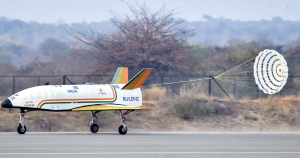NEW DELHI: The Indian Space Research Organisation (ISRO) has successfully conducted the Pushpak Reusable Landing Vehicle (RLV) LEX 02 landing experiment at the Aeronautical Test Range in Chitradurga in Karnataka on Friday.
The RLV LEX 02 landing experiment is the second of the series of experiments conducted by the space agency.
The test was conducted at 7.10 am today, according to a statement by ISRO.
“ISRO nails it again. Pushpak (RLV-TD), the winged vehicle, landed autonomously with precision on the runway after being released from an off-nominal position,” the space agency said in a tweet on social media platform X.
ISRO said that after first the RLV-LEX-01 mission which was accomplished last year, the RLV-LEX-02 demonstrated the autonomous landing capability of RLV off-nominal initial conditions at the release from a Chinook helicopter. The RLV was made to undertake more difficult amnoeuvers with dispersions, correct both cross-range and down range and land on the runway in a fully autonomous mode.
“The winged vehicle, called Pushpak was lifted by an Indian Air Force Chinook Helicopter and was released from 4.5 km altitude. After release at a distance of 4 km from the runway, Pushpak autonomously approached the runway along with cross-range corrections. It landed precisely on the runway and came to a halt using its brake parachute landing gear brakes and nose wheel steering system,” ISRO said.
The mission successfully simulated the approach and high-speed landing conditions of RLV returning from space, it said.
“With this second mission, ISRO had re-validated the indigenously developed technologies in the areas of navigation, control systems. landing gear and deceleration systems essential for performing high speed autonomous landing of a space returning vehicle,” ISRO said.
It added that the winged body and all flight systems used in RLV-LEX-01 were reused in the RLV-LEX-02 mission after due certification and clearances.
“Hence reuse capability of flight hardware and flight systems is also demonstrated in this mission. Based on observations from RLV-LEX-01, the airframe structure and landing gear were strengthened to tolerate higher landing loads,” ISRO said.
ISRO chairman S Somnath congratulated the team for the flawless execution of the complex mission.
ISRO’s Vikram Sarabhai Space Centre (VSSC) Director Dr S Unnikrishnan Nair said that through this repeated success, ISRO could master the terminal phase maneuvering, landing and energy management in a fully autonomous mode, which is a critical step towards the future Orbital Re-entry missions.
The mission was accomplished by Vikram Sarabhai Space Centre (VSSC) along with the Liquid Propulsion System Centre (LPSC) and the ISRO Inertial Systems Unit (IISU).
Collaboration from various agencies including IAF, ADE, ADRDE and CEMILAC contributed to the success of the mission.
The team was guided by Sunil P, Programme Director, Advanced Technology and Systems Programme, VSSC. J Muthupandian, Project Director, RLV was the Mission Director and B Karthik, Deputy Project Director, RLV was the Vehicle Director for this mission, ISRO said.

